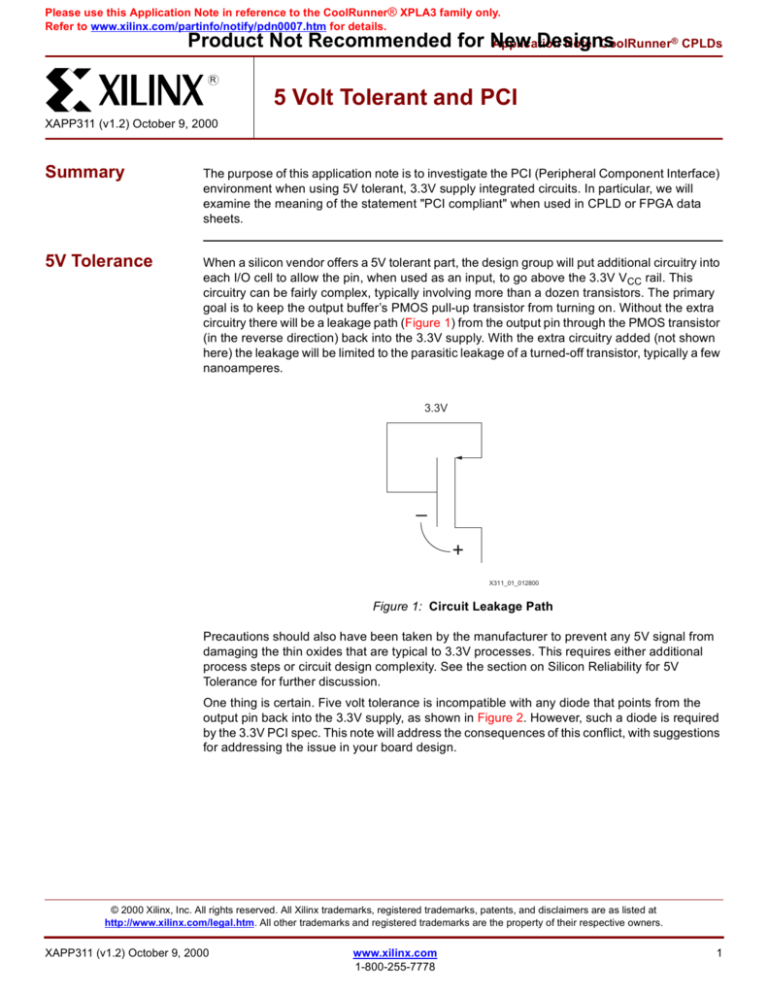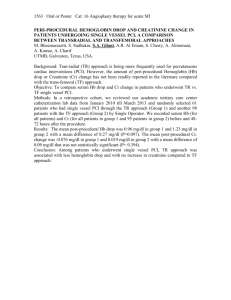
Please use this Application Note in reference to the CoolRunner® XPLA3 family only.
Refer to www.xilinx.com/partinfo/notify/pdn0007.htm for details.
Product Not Recommended for New
Designs
Application
Note: CoolRunner® CPLDs
R
5 Volt Tolerant and PCI
XAPP311 (v1.2) October 9, 2000
Summary
The purpose of this application note is to investigate the PCI (Peripheral Component Interface)
environment when using 5V tolerant, 3.3V supply integrated circuits. In particular, we will
examine the meaning of the statement "PCI compliant" when used in CPLD or FPGA data
sheets.
5V Tolerance
When a silicon vendor offers a 5V tolerant part, the design group will put additional circuitry into
each I/O cell to allow the pin, when used as an input, to go above the 3.3V VCC rail. This
circuitry can be fairly complex, typically involving more than a dozen transistors. The primary
goal is to keep the output buffer’s PMOS pull-up transistor from turning on. Without the extra
circuitry there will be a leakage path (Figure 1) from the output pin through the PMOS transistor
(in the reverse direction) back into the 3.3V supply. With the extra circuitry added (not shown
here) the leakage will be limited to the parasitic leakage of a turned-off transistor, typically a few
nanoamperes.
3.3V
–
+
X311_01_012800
Figure 1: Circuit Leakage Path
Precautions should also have been taken by the manufacturer to prevent any 5V signal from
damaging the thin oxides that are typical to 3.3V processes. This requires either additional
process steps or circuit design complexity. See the section on Silicon Reliability for 5V
Tolerance for further discussion.
One thing is certain. Five volt tolerance is incompatible with any diode that points from the
output pin back into the 3.3V supply, as shown in Figure 2. However, such a diode is required
by the 3.3V PCI spec. This note will address the consequences of this conflict, with suggestions
for addressing the issue in your board design.
© 2000 Xilinx, Inc. All rights reserved. All Xilinx trademarks, registered trademarks, patents, and disclaimers are as listed at
http://www.xilinx.com/legal.htm. All other trademarks and registered trademarks are the property of their respective owners.
XAPP311 (v1.2) October 9, 2000
www.xilinx.com
1-800-255-7778
1
Please use this Application Note in reference to the CoolRunner® XPLA3 family only.
Refer to www.xilinx.com/partinfo/notify/pdn0007.htm for details.
5 Volt Tolerant and PCI
Product Not Recommended for New Designs
R
3.3V
X311_02_012800
Figure 2: 5V Tolerance Incompatibility
3.3V PCI and
Diode Clamping
The PCI electrical spec is defined in such a way as to provide open termination incident wave
switching across a wide range of board impedances. It does this by defining minimum and
maximum driving impedances for the ICs output buffers. The PCI specification also stipulates
mandatory use of an input clamp diode to VCC for 3.3V signaling. The reason for this is to
ensure signal integrity at the input pin by preventing the resultant ringing on low-to-high edges
from dipping below the switching threshold. To see this, consider the unclamped case, which is
shown in Figure 3. A 3.3V output signal from a 10 ohm source impedance1 into a 70 ohm
transmission line will generate an incident wave voltage of 5.8V at the receiving end. After two
flight delays, a negative reflected wave will follow, getting dangerously close to the upper end
of the input threshold2.
(Unterminated)
10 Ohms
70 Ohm Line
Input Buffer
3.3V
5.8V
2.9V
THE PROBLEM
X311_03_012800
Figure 3: Unclamped Example
(Although this discussion is aimed at PCI applications, note that the same issue can exist in any
board design with open termination transmission lines.)
The overshoot voltage can be this high because the input buffer is an open impedance, due to
its 5V tolerance. The addition of an external clamp diode to the 3.3V supply will dampen this
overshoot and reduce the ringing sufficiently to avoid spurious threshold transitions.
It might occur to the reader that a programmable diode at each pin would be a nice feature onchip. This has actually been implemented on at least one PLD. The PCI spec requires that the
diode (and a series switching device) be able to pass a current of 25 mA with a forward drop of
less than 1V. The silicon area required of such a diode and switch is roughly as large as the
output buffer transistors, too large an area to justify except in special applications. (If these
components are not used, the area must still be paid for.)
2
www.xilinx.com
1-800-255-7778
XAPP311 (v1.2) October 9, 2000
Please use this Application Note in reference to the CoolRunner® XPLA3 family only.
Refer to www.xilinx.com/partinfo/notify/pdn0007.htm for details.
5 Volt Tolerant and PCI
Product Not Recommended for New Designs
R
A 3.3V PLD which stipulates in its data sheet that it is "PCI complian" while also offering 5V
tolerance is probably referring to the electrical drive characteristics of the output buffer. (The
minimum and maximum source impedances referred to previously.) If a particular pin is used in
a PCI environment, an external clamp diode will need to be added at that pin, for the reasons
shown above.
5V PCI
Singaling
It is also possible to consider use of 3.3V PLDs within a 5V PCI environment. Output buffers
designed for 3.3V operation generally drive to the VCC rail, and these can meet the PCI spec if
the PMOS pull-up transistor is sufficiently large. The values of allowable drive impedances for
both 3.3V and 5.5V signaling are shown in Figure 4 and Figure 5. (Note that the VCCIO is 3.3V
in both cases.)
3.3V Signaling
3.3V
10-58 Ohms
5-37 Ohms
X311_04_012800
Figure 4: 3.3V Signaling
5.5V Signaling
3.3V
4-36 Ohms
4-23 Ohms
X311_05_012800
Figure 5: 5V Signaling
As can be seen, there is sufficient overlap in the specification to make it feasible for an output
buffer to be electrically compatible with both 3.3V and 5V PCI signaling. Note, however, that it
is possible for a device to satisfy the 3.3V specification, but not have sufficient drive for the 5V
signaling environment. The 3.3V component vendor should be clear when specifying PCI
electrical compatibility as to the specific signaling environment(s) that it adheres to.
XAPP311 (v1.2) October 9, 2000
www.xilinx.com
1-800-255-7778
3
Please use this Application Note in reference to the CoolRunner® XPLA3 family only.
Refer to www.xilinx.com/partinfo/notify/pdn0007.htm for details.
5 Volt Tolerant and PCI
Product Not Recommended for New Designs
R
(It may seem strange that a 5V PCI signal can be driven with a 3.3V signal. However, the 5V
PCI threshold was put at TTL levels (centered around 1.4V), with a 2.0V guaranteed high level.
This permits a 3.3V output driver to interface to the bus, as long as the drive impedances are
low enough.)
The PCI specification requires that a 5V PCI compatible device be able to withstand repeated
application of 11V pulses sourced through a 22 ohm resistor without damage. For 5V tolerant
pins, this mandates the use of an external clamp diode. The application of 11V to an
unprotected I/O structure will cause damage.
The reason for this specification is that when a device receives a 5V PCI signal as an input
(either to a dedicated input pin or to a 3-stated I/O pin) the PCI signal will, by design, overshoot
to well above the 5V supply. Although "5V tolerant" parts can normally accept signals on the
bus up to 5.5V (5V + 10%) the overshoot of an unclamped PCI signal can be well over seven
volts. For this reason, a clamp diode must be added from the pin to the 5V board supply. Xilinx
devices that are specified for 5V PCI signaling are able to withstand an absolute maximum
voltage of 6.5V safely. This rating gives the margin needed to allow a diode forward voltage
drop above the 5.5V supply. If a vendor specifies an absolute maximum on the input pins less
than 6V, this is not high enough to give reliable operation in a 5V PCI signaling environment.
Silicon
Reliability for
5V Tolerance
A 3.3V operation,3-statable output buffer which does not have 5V tolerance will clamp at a
diode above VCC (see Figure 6). A 5V tolerant output structure in its most basic form includes
a switch which allows the n-well of the PMOS output driver to follow the output pin voltage
upwards. Additional circuitry is added to keep the PMOS transistor from turning on in the
"upside down" direction when the output pin rises above VCC. The equivalent circuit of the
PMOS transistor when 5V is applied to the pin is shown in Figure 7. The transistor is off and
there are no leakage currents.
3.3V
n-Well
Parasitic Diode
X311_06_012800
Figure 6: Output Buffer without 5V Tolerance
3.3V
5V
X311_07_012800
Figure 7: Equivalent PMOS Circuit
4
www.xilinx.com
1-800-255-7778
XAPP311 (v1.2) October 9, 2000
Please use this Application Note in reference to the CoolRunner® XPLA3 family only.
Refer to www.xilinx.com/partinfo/notify/pdn0007.htm for details.
5 Volt Tolerant and PCI
Product Not Recommended for New Designs
R
There is an additional problem, however, that must be addressed by the PLD vendor. Take a
look at a typical NMOS output structure shown in Figure 8. (The PMOS and its circuitry have
been removed for clarity.) The 5V at the pin is a signal on the bus connected to this tri-stated
output buffer.
5V (Applied)
0V
(OFF)
X311_08_012800
Figure 8: Typical NMOS Output Structure
PLD devices which are targeted to the 3.3V market are currently manufactured with 0.35
micron technology. The wafer process used at this technology level will typically use a gate
oxide thickness of 75 Angstroms (7.5 nm). Since the gate of the NMOS drive transistor is
grounded to turn it off for 3-stating, the 5V at the output will appear across the drain-gate oxide
region, creating a field of 6.7 MV/cm. The semiconductor industry has consistently kept CMOS
operating voltages to around 5 MV/cm because of the damage that will occur to gate oxides at
7 MV/cm and higher3. In this case, 5V applied to the output pin (even though the pin is "5V
tolerant") will come close to the critical value. Signal overshoot or supply voltage variation can
easily cause this field to go higher. (The oxide degradation is cumulative, so short pulses over
an extended time will eventually cause failure.)
The failure mode is not necessarily an oxide rupture. Injected charge trapped in the gate oxide
can cause threshold shifts which gradually degrade the drive performance of the NMOS
transistor, leading to slower speeds in the output buffer, especially with higher capacitive loads
or (as in the case of this application note) in transmission line environments.
There are at least two approaches that the vendor can take to prevent this situation from
occurring. One is to use a second, thicker, gate oxide for output transistors. This will lower the
electric field to an acceptable level. (This particular approach is commonly used in 5V capable
outputs, meaning the output buffer can actually drive 5V rail-to-rail signals by using a separate
5V I/O power supply.) However, the additional oxide step and associated masks add significant
cost to the wafer, and this approach is usually not used for generating 5V tolerant circuits.
A second approach, and the one taken by Xilinx, is to add a second transistor in a cascade
connection, with the gate connected to the 3.3V supply (see Figure 9). A thicker gate oxide is
not needed, since the voltage across the gate is reduced. With the absolute maximum input
voltage, 6.5V, that is specified with Xilinx devices (during the PCI 5V signaling overshoot
condition), the voltage across the second transistor’s drain-gate oxide region is only 3.2V, less
than the part’s normal supply voltage. It is apparent that if this 6.5V signal was applied to a
single NMOS pulldown transistor (and assuming 75 Angstroms of gate oxide thickness) the
field would be over 8 MV/cm. This is considered within the industry to be generally
unacceptable.
XAPP311 (v1.2) October 9, 2000
www.xilinx.com
1-800-255-7778
5
Please use this Application Note in reference to the CoolRunner® XPLA3 family only.
Refer to www.xilinx.com/partinfo/notify/pdn0007.htm for details.
5 Volt Tolerant and PCI
Product Not Recommended for New Designs
R
5V (Applied)
3.3V
0V
Cascade NMOS Transistor
(OFF)
X311_09_012800
Figure 9: Cascade Connection
Although the previous discussion looks specifically at a tri-statable output buffer, it should be
noted that similar circuit techniques are needed in the input buffers. (For example, an input pin
should not be wired directly to the gate of a grounded source NMOS transistor.) Xilinx PLDs
have special circuitry at all input buffers to guarantee that the maximum field limits required by
the process are not exceeded.
Conclusion
PCI electrical compatibility can be obtained with 5V tolerant, 3.3V operation, PLD devices.
However, the manufacturer should explicitly specify compatibility with 3.3V and/or 5V signaling.
In either case, the board designer is responsible for adding the necessary clamp diodes at the
input and I/O pins. These clamp diodes are needed for:
•
•
Signal integrity (3.3V signaling)
Reliability (5V signaling).
Care should be taken by the vendor to ensure, either by process or design techniques, that the
input and I/O pins are capable of withstanding the overvoltages expected in PCI environments.
References
1. The 10 ohm value is from line CE26 of the PCI Electrical Checklist, Revision 2.1. This is the minimum
allowed drive impedance.
2.
The 3.3 volt PCI threshold spec is centered at 0.4 x VCC, ±0.1 x VCC.
3. See, for example, Chapter 4 of T. Hori, “Gate dielectrics and MOS ULSIs” Springer Verlag, N.Y.,
1997.
Revision
History
6
The following table shows the revision history for this document.
Date
Version
Revision
02/14/00
1.1
Converted to Xilinx format.
10/09/00
1.2
Added Applicatiion Note reference to header.
www.xilinx.com
1-800-255-7778
XAPP311 (v1.2) October 9, 2000









